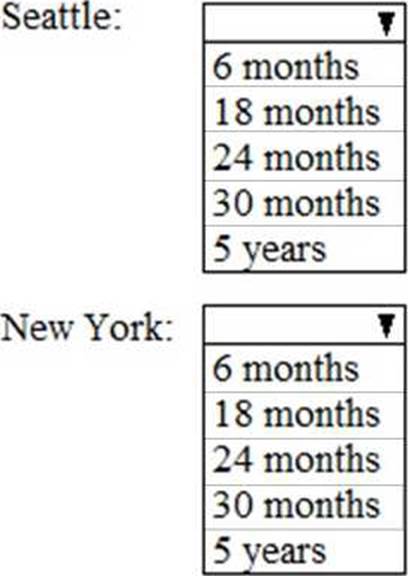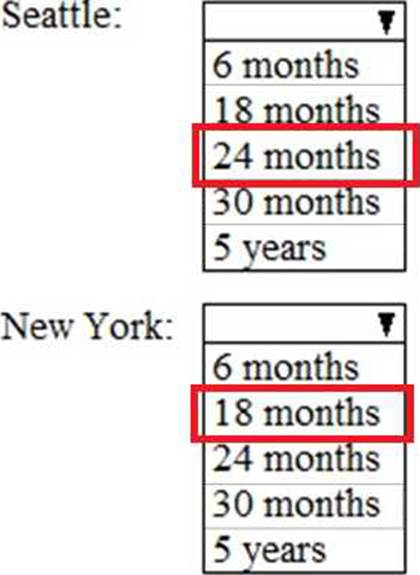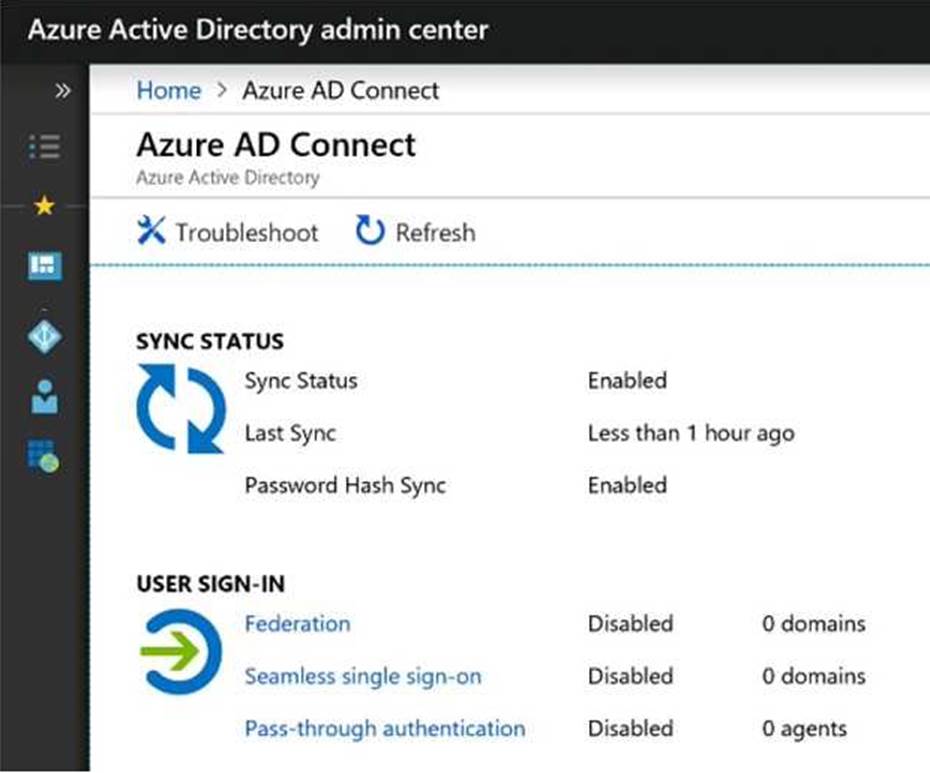Microsoft MS-102 Real Exam Questions
The questions for MS-102 were last updated at Jan 19,2025.
- Exam Code: MS-102
- Exam Name: Microsoft 365 Administrator
- Certification Provider: Microsoft
- Latest update: Jan 19,2025
You have a Microsoft 365 tenant that contains a Windows 10 device named Device1 and the Microsoft Endpoint Manager policies shown in the following table.

- A . only the settings of Policy!
- B . only the settings of Policy2
- C . only the settings of Policy3
- D . no settings
HOTSPOT
As of March, how long will the computers in each office remain supported by Microsoft? To answer, select the appropriate options in the answer area. NOTE: Each correct selection is worth one point.


Explanation:
https://support.microsoft.com/en-gb/help/13853/windows-lifecycle-fact-sheet March Feature Updates: Serviced for 18 months from release date September Feature Updates: Serviced for 30 months from release date
Reference: https://www.windowscentral.com/whats-difference-between-quality-updates-and-feature-updates-windows-10
You enable the Azure AD Identity Protection weekly digest email.
You create the users shown in the following table.

Which users will receive the weekly digest email automatically?
- A . Admin2, Admin3, and Admin4 only
- B . Admin1, Admin2, Admin3, and Admin4
- C . Admin2 and Admin3 only
- D . Admin3 only
- E . Admin1 and Admin3 only
E
Explanation:
By default, all Global Admins receive the email. Any newly created Global Admins, Security Readers or Security Administrators will automatically be added to the recipients list.
Note: This question is part of a series of questions that present the same scenario. Each question in the series contains a unique solution that might meet the stated goals. Some question sets might have more than one correct solution, while others might not have a correct solution.
After you answer a question in this section, you will NOT be able to return to it. As a result, these questions will not appear in the review screen.
You have a computer that runs Windows 10.
You need to verify which version of Windows 10 is installed.
Solution: From Device Manager, you view the computer properties.
Does this meet the goal?
- A . Yes
- B . No
B
Explanation:
Reference: https://support.microsoft.com/en-us/windows/which-version-of-windows-operating-system-am-i-running-628bec99-476a-2c13-5296-9dd081cdd808
HOTSPOT
You have a Microsoft 365 E5 tenant that contains the users shown in the following table.

You provision the private store in Microsoft Store for Business.
You assign Microsoft Store for Business roles to the users as shown in the following table.

You need to identify which users can add apps to the private store, and which users can assign apps from Microsoft Store for Business.
Which users should you identify? To answer, select the appropriate options in the answer area. NOTE: Each correct selection is worth one point.


Explanation:
Reference:
https://docs.microsoft.com/en-us/microsoft-store/roles-and-permissions-microsoft-store-for-business
https://docs.microsoft.com/en-us/education/windows/education-scenarios-store-for-business#basic-purchaser-role
Note: This question is part of a series of questions that present the same scenario. Each question in
the series contains a unique solution that might meet the stated goals. Some question sets might have more than one correct solution, while others might not have a correct solution.
After you answer a question in this section, you will NOT be able to return to it. As a result, these questions will not appear in the review screen.
Your network contains an on-premises Active Directory domain. The domain contains domain controllers that run Windows Server 2019. The functional level of the forest and the domain is Windows Server 2012 R2.
The domain contains 100 computers that run Windows 10 and a member server named Server1 that runs Windows Server 2012 R2.
You plan to use Server1 to manage the domain and to configure Windows 10 Group Policy settings.
You install the Group Policy Management Console (GPMC) on Server1.
You need to configure the Windows Update for Business Group Policy settings on Server1.
Solution: You copy the Group Policy Administrative Templates from a Windows 10 computer to Server1.
Does this meet the goal?
- A . yes
- B . No
HOTSPOT
You have a Microsoft 365 E5 tenant that contains the users shown in the following table.

The tenant contains the devices shown in the following table.

You have the apps shown in the following table.

You plan to use Microsoft Endpoint Manager to manage the apps for the users.
For each of the following statements, select Yes if the statement is true. Otherwise, select No. NOTE: Each correct selection is worth one point.


Explanation:
Reference:
https://docs.microsoft.com/en-us/mem/intune/apps/apps-deploy
https://docs.microsoft.com/en-us/mem/intune/apps/apps-windows-10-app-deploy
You have a Microsoft 365 subscription that contains a user named User1.
You need to ensure that User1 can search the Microsoft 365 audit logs from the Security & Compliance admin center.
Which role should you assign to User1?
- A . View-Only Audit Logs in the Security & Compliance admin center
- B . View-Only Audit Logs in the Exchange admin center
- C . Security reader in the Azure Active Directory admin center
- D . Security Reader in the Security & Compliance admin center
B
Explanation:
Reference: https://docs.microsoft.com/en-us/microsoft-365/compliance/search-the-audit-log-in-security-and-compliance?view=o365-worldwide
HOTSPOT
You create the Microsoft 365 tenant.
You implement Azure AD Connect as shown in the following exhibit.

Use the drop-down menus to select the answer choice that completes each statement based on the information presented in the graphic. NOTE: Each correct selection is worth one point.


Explanation:
Box 1: only on-premises
In the exhibit, seamless single sign-on (SSO) is disabled. Therefore, as SSO is disabled in the cloud, the Sales department users can access only on-premises applications by using SSO.
In the exhibit, directory synchronization is enabled and active. This means that the on-premises Active Directory user accounts are synchronized to Azure Active Directory user accounts. If the on-premises Active Directory becomes unavailable, the users can access resources in the cloud by authenticating to Azure Active Directory. They will not be able to access resources on-premises if the on-premises Active Directory becomes unavailable as they will not be able to authenticate to the on-premises Active Directory.
Box 2: in the cloud only
You need to protect the U.S. PII data to meet the technical requirements.
What should you create?
- A . a data loss prevention (DLP) policy that contains a domain exception
- B . a Security & Compliance retention policy that detects content containing sensitive data
- C . a Security & Compliance alert policy that contains an activity
- D . a data loss prevention (DLP) policy that contains a user override
